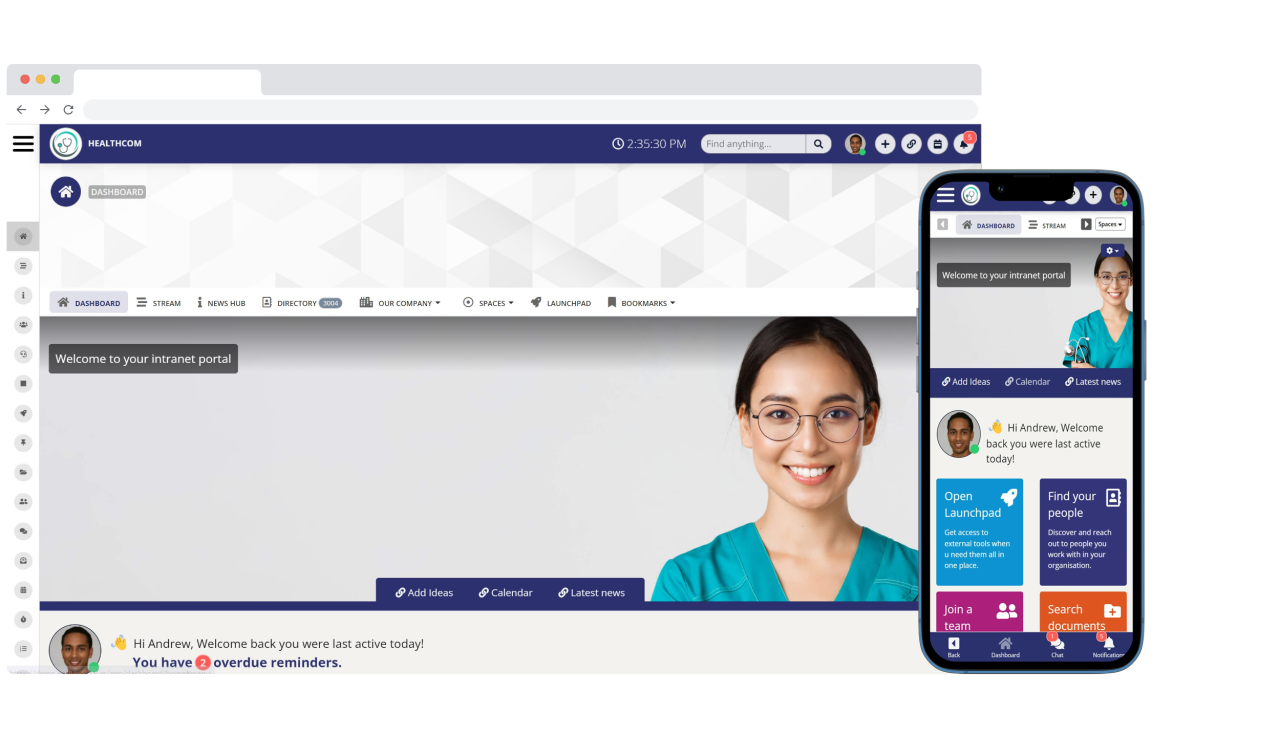Insight Blog
Agility’s perspectives on transforming the employee's experience throughout remote transformation using connected enterprise tools.
16 minutes reading time
(3127 words)
The true cost of disengaged employees
According to Gallup, engagement fell from 36% in 2020 to 34% in 2021. Conversely, active disengagement fell by four points from 2020 to 2021 and two points from 2021 to 2022. But this year's data shows that 18% of full- and part-time employees are actively disengaged.
Employee disengagement poses a significant threat to your business, leading to adverse outcomes in various aspects.
Gallup cost of disengaged employees, recent Gallup research indicates a troubling trend, with employee engagement dropping from 36% in 2020 to 34% in 2021, marking the first decline in a decade.
Despite a reduction in actively disengaged employees, an alarming 18% of both full-time and part-time workers remain disengaged.
Disengaged employees exhibit reduced productivity, decreased teamwork, increased absenteeism, and elevated turnover rates, all of which can detrimentally affect your company's profitability.
The manifestations of employee disengagement and its genuine repercussions for businesses:
- Reduced Productivity: Disengaged employees are less inclined to exert their full effort and are more prone to procrastination and careless errors. Consequently, this results in diminished output and a decline in product or service quality.
- Diminished Teamwork: Disengaged employees are less likely to collaborate with their colleagues or actively engage in team projects. This fosters a negative work environment and impedes the achievement of common objectives.
- Increased Absenteeism: Disengaged employees tend to take more sick days or leave work early, causing disruptions in workflow and an increased workload for other team members.
- Elevated Turnover Rates: Disengaged employees are more likely to seek alternative job opportunities, leading to substantial costs related to recruitment and onboarding, along with the loss of valuable institutional knowledge.
The financial repercussions of employee disengagement can be staggering. Studies reveal that disengaged employees cost U.S. businesses a staggering $450 billion annually in lost productivity.
Furthermore, companies with high turnover rates expend an average of 21% of their payroll on replacing departed employees.
What Is Employee Disengagement?
Employee disengagement refers to a state where employees lack enthusiasm and active involvement in their work environment.
It stands in stark contrast to employee engagement, where individuals display a deep passion for their tasks and a genuine commitment to the success of their organization.
In cases of employee disengagement, individuals often limit their efforts to the bare minimum required for their job, devoid of any real zeal, vitality, or a willingness to exceed expectations.
In cases of employee disengagement, individuals often limit their efforts to the bare minimum required for their job, devoid of any real zeal, vitality, or a willingness to exceed expectations.
Such employees may exhibit apathy towards their work and the overall goals of the organization. As per a 2022 report, disengaged employees make up a substantial 60% of the global workforce.
Actively disengaged employees pose an even more significant concern.
These individuals may actively work against the achievements of engaged colleagues, express negative sentiments regarding their co-workers, projects, or management, and be more inclined to seek new job opportunities elsewhere.
What Causes Employees to Disengage?
Employee disengagement frequently originates from various workplace issues. Some common factors contributing to disengagement include the absence of clearly defined expectations, inadequacy in the availability of necessary materials and equipment, and a disconnect from their company's mission and purpose.
There are several recognized causes of employee disengagement, which encompass:
- Leadership: Poor leadership, a lack of trust in leaders, and the absence of meaningful relationships with managers can all foster employee disengagement.
- Workload: Overwhelming workloads, unrealistic deadlines, and insufficient resources can all hinder employees from feeling engaged and motivated.
- Communication: Inadequate communication, a lack of transparency, and insufficient feedback can contribute to employee disengagement.
- Growth Opportunities: The absence of prospects for professional development and career advancement can leave employees feeling stagnant and unmotivated.
- Compensation and Benefits: Inadequate pay and benefits, along with a dearth of recognition and rewards, can play a role in employee disengagement.
- Work-Life Balance: A poor work-life balance, prolonged working hours, and a lack of flexibility can make it challenging for employees to maintain engagement and job satisfaction.
- Culture and Values: A toxic workplace culture, a misalignment with company values, and a sense of purposelessness can contribute to employee disengagement.
- Personal Factors: Personal issues, such as health concerns, family obligations, and financial stresses, may also be factors contributing to employee disengagement.
It's important to note that poor management, such as failing to provide constructive feedback, can lead to the development of actively disengaged employees.
According to Gallup's State of the American Manager report, nearly one in every two workers has, at some point in their career, left their job, partially due to issues related to their manager.
This underscores the significant impact that management quality can have on employee engagement and overall workplace satisfaction.
The Stages of Employee Disengagement
There are various ways to categorize the different phases of employee disengagement. Some people define them as steps within a process or workflow, similar to the five stages of grief (denial, anger, bargaining, depression, and acceptance), while others arrange them based on their severity.
In this discussion, we will primarily focus on classifying the different stages of disengagement by their level of severity. It's important to note that these are general categories, and employees may not necessarily progress through every stage of disengagement in the specified order.Here, you will find descriptions of the various degrees of disengagement and their corresponding symptoms, as reported by AgilityPortal users and other reputable sources.
The 3 stages of employee disengagement can be summarized as follows:
- Early Signs of Disengagement: At this initial stage, employees may exhibit subtle signs of disengagement, such as decreased enthusiasm for their work, reduced productivity, and a lack of motivation. They may also begin to disengage from their colleagues and workplace activities. Early signs often go unnoticed or are dismissed as temporary issues.
- Intermediate Disengagement: As disengagement progresses, employees may become more withdrawn and less proactive. They might show increased absenteeism, display a negative attitude, and start to disengage from company goals and values. Their performance may decline further, and they may express dissatisfaction with their job. Colleagues and supervisors may start to notice these changes, but they may not address them effectively.
- Advanced Disengagement: In the final and most critical stage, disengaged employees become actively disengaged. They may exhibit behaviors such as undermining the work of engaged colleagues, openly criticizing the company, its management, and their peers, and actively seeking new job opportunities. The impact of advanced disengagement can be detrimental to the individual employee, the team, and the organization as a whole. Addressing disengagement at this stage can be more challenging, but it is essential to prevent further damage and loss of talent.
Recognizing these stages of employee disengagement is crucial for organizations to take proactive measures to address the issue and re-engage their workforce before it reaches an advanced and potentially irreversible stage.
How to Calculate the Cost of Employee Disengagement
Although you might be witnessing the adverse effects of employee disengagement in your organization, substantiating these issues with data is vital to strengthen your argument.
This becomes particularly crucial when you're aiming to construct a business case for internal communications software, employee engagement apps, and other tools designed to enhance engagement.
The significance of internal communication extends far beyond the mere dissemination of information about team absences and software updates. Employee communications are specifically crafted to promote and drive employee engagement.
So the impact of employee disengagement on attrition and productivity is big right, here are several essential steps to illustrate the impact of employee disengagement on your business.
To calculate the financial impact of employee disengagement, you can use the following formula:
Cost of employee disengagement = (Average salary) * (1 - Average performance rating) * (1 - Average engagement score)
Here's a breakdown of the formula:
- Average salary: This is the mean salary of all employees in your company.
- Average performance rating: This represents the average performance rating of all employees in your organization.
- Average engagement score: This denotes the average employee engagement score across your workforce.
The cost of employee disengagement serves as a quantifiable measure of the adverse effects of disengaged employees on a company. Disengaged employees tend to be less productive, more prone to errors, and more likely to leave the organization. These consequences can lead to various costs, including decreased productivity, increased turnover expenses, and reduced customer satisfaction.
To calculate the cost of employee disengagement for your specific company, you'll need to gather data regarding employee salaries, performance ratings, and engagement scores.
Utilizing this data, you can compute the average salary, average performance rating, and average engagement score for all your employees. Once you have these values, you can plug them into the formula mentioned above to determine the cost of employee disengagement.
Here's an illustrative example of how to calculate the cost of employee disengagement:
Example:
- Average salary = $100,000
- Average performance rating = 0.8
- Average engagement score = 0.6
Cost of employee disengagement = ($100,000) * (1 - 0.8) * (1 - 0.6) = $16,000
This calculation reveals that, on average, disengaged employees cost the company approximately $16,000 per year each.
It's important to note that the cost of employee disengagement may vary depending on factors like industry, company size, and other specific circumstances. However, the provided formula can provide a rough estimate of the cost of employee disengagement for your organization.
Here are some recommendations for mitigating the cost of employee disengagement:
- Enhance employee engagement: Implement strategies to boost employee engagement, such as offering meaningful work, opportunities for growth and development, and fostering a positive work environment.
- Reduce turnover: High employee turnover can be costly in terms of recruitment, hiring, and training expenses. Reducing turnover can help save resources.
- Improve productivity: Engaged employees tend to be more productive. By increasing employee engagement, companies can enhance productivity and subsequently increase profits.
How to Motivate an Employee Who is Disengaged
As soon as you detect the initial indicators of employee disengagement, it's crucial to take swift action. The sooner you address the problem, the lower the long-term costs for your company. Here are some best practices for enhancing employee engagement to help you get started on the right path:
Here are some key strategies to improve employee engagement:- Regular Surveys: To better understand how to engage disengaged employees, consider seeking feedback directly from your staff. Use pulse surveys, like those provided by AgilityPortal, to collect anonymous input and ask open-ended questions about employee engagement. Conduct these surveys on a recurring basis to track progress effectively.
- Prioritize Work-Life Balance: Employee disengagement often results from stress and exhaustion. To combat this, provide more wellness resources and benefits, such as offering unlimited vacation days, to help employees avoid burnout and maintain their engagement.
- Enhance Employee Recognition: Show appreciation for your employees' hard work. Recognizing their efforts fosters motivation and encourages them to envision a future with your organization using AgilityPortal
- Offer Professional Development Opportunities: Employees may disengage if they feel their job offers no growth potential. To address this, provide coaching and professional development opportunities to help your staff realize their full potential within your company.
- Improve Internal Communication: Make it easy for your employees to access important information about your organization. Streamline your internal communication design using tools like email analytics and click maps to ensure efficient and stress-free information sharing.
How does employee disengagement influence productivity?
In this section we will explore the how does employee disengagement influence productivity?
Employee disengagement exerts a significantly detrimental influence on productivity.
Disengaged employees tend to exhibit diminished motivation, focus, and efficiency in their tasks, often succumbing to procrastination, missing deadlines, and committing more errors.
Critical factors that influence employee engagement, they are less inclined to go the extra mile or embrace new challenges.
Here are several specific manners in which employee disengagement can impact productivity:
- Diminished output: Disengaged employees either produce a reduced quantity of work or deliver work of lower quality. They might also take longer to complete their assignments.
- Elevated errors: Disengaged employees have a higher likelihood of making errors in their work, which can result in rework, project delays, and customer dissatisfaction.
- Decreased efficiency: In comparison to engaged counterparts, disengaged employees are less efficient in their daily tasks. They may squander time on non-essential activities or exhibit reduced focus on their work.
- Limited innovation: Disengaged employees are less likely to generate novel ideas or innovative solutions to challenges, thereby inhibiting the organization's progress and innovation.
Research has unequivocally demonstrated that disengaged employees exact a considerable financial toll on organizations each year due to lost productivity.
For instance, a Gallup study found that disengaged employees are 60% more prone to committing errors in the workplace.
Another investigation by Towers Watson revealed that disengaged employees are 18% less productive compared to their engaged counterparts.
How to Prevent Disengagement from Occuring in the first place
Preventing employee disengagement is the most effective approach. While it may pose challenges, we have has identified a few ways, Below are some examples that can benefit every industry in engaging their employees:
- Cultivate a Recognition Culture: Establish a culture of recognition that permeates all facets of your organization. Incorporate both formal and informal recognition into your strategic recognition platform.
- Empower with Resources:Empower employees to acquire new skills for career advancement. Recognize and reward those employees who seize these opportunities to learn and enhance their abilities.
- Prioritize Communication:Consistently communicate and embody your organization's values and vision. Recognize employees who contribute to the quality of the organization's work, products, and services.
Solve this problem now and cut the costs of employee disengagement with AgilityPortal
In an era marked by the significant rise in employee resignations, disengaged employees can be detrimental to your organization. Over time, neglecting the indicators of a disengaged workforce will result in substantially higher costs compared to proactively investing in employee engagement.
Here's how AgilityPortal can assist you in reducing the expenses associated with employee disengagement:
AgilityPortal offers various features that can help address and mitigate employee disengagement in the workplace.
Here are some of the key features that can be leveraged to tackle this issue:
- Internal Communication Tools: AgilityPortal provides communication tools such as chat, forums, and newsfeeds to facilitate transparent and effective communication within the organization. Clear and open communication is essential for keeping employees engaged and informed.
- Employee Feedback Surveys: The platform can enable the creation and distribution of employee surveys to gather feedback and insights on their engagement levels and the factors contributing to disengagement. This data can inform decision-making and targeted interventions.
- Performance Management: AgilityPortal offers performance management tools, allowing managers to set clear expectations, provide regular feedback, and track employee progress. This can help employees understand their goals and how they are contributing to the organization.
- Training and Development Modules: The platform can support training and development initiatives. Offering opportunities for skill-building and career advancement can boost engagement by showing employees that their growth is a priority.
- Recognition and Rewards System: AgilityPortal can facilitate the implementation of a recognition and rewards program, where employees are acknowledged and rewarded for their contributions. This recognition can boost morale and engagement.
- Employee Self-Service: Enabling employees to access and manage their own information, schedules, and benefits through AgilityPortal can increase their sense of control and engagement.
- Work-Life Balance Features: The platform can support flexible work arrangements and scheduling, promoting a healthy work-life balance that reduces stress and burnout, leading to improved engagement.
- Goal Tracking and Progress Visualization: AgilityPortal allows employees to track their individual goals and visualize their progress. This feature can motivate employees to work towards their objectives, increasing engagement.
- Social Collaboration and Networking: Creating opportunities for employees to connect and collaborate through social features in AgilityPortal can enhance their sense of belonging and engagement.
- Analytics and Reporting: AgilityPortal provides data analytics and reporting capabilities, allowing organizations to monitor employee engagement metrics, identify trends, and measure the impact of their engagement initiatives.
- Leadership and Management Tools: The platform can support leadership development and management training programs, ensuring that leaders are equipped to create a positive and engaging work environment.
- Employee Assistance Resources: AgilityPortal can be used to provide access to employee assistance programs, wellness resources, and support services to help employees address personal or professional challenges that may affect their engagement.
These features, when used effectively within AgilityPortal, can help organizations address employee disengagement by fostering a positive and engaging workplace culture, promoting communication, and providing the tools and resources needed for employee growth and satisfaction.
Free ebook: How To Get Your Intranet Off The Ground
Wrapping up
Employee engagement is crucial for the overall success of an organization. Engaged employees are more productive, motivated, and committed to their work, leading to improved performance and higher job satisfaction. They are also more likely to stay with the company, reducing turnover rates and associated recruitment and training costs. Engaged employees tend to be more innovative and provide better customer service, positively impacting the company's reputation and profitability. Additionally, a highly engaged workforce creates a positive work culture, fostering collaboration and employee well-being.
What HR Managers Can Do:
HR managers play a central role in fostering employee engagement. They can:
- Define Clear Expectations: Ensure that employees have a clear understanding of their roles and responsibilities, as this minimizes confusion and frustration.
- Provide Growth Opportunities: Offer training and development programs to help employees learn new skills and advance in their careers. These opportunities demonstrate the organization's commitment to their growth.
- Implement Recognition and Reward Systems: Recognize and reward employees for their contributions, whether through formal recognition programs, bonuses, or promotions. This encourages motivation and a sense of appreciation.
- Maintain Effective Communication: Promote open and transparent communication channels within the organization. HR managers can facilitate regular feedback sessions and encourage employees to voice their concerns.
How Software Tools Can Facilitate:
HR managers can leverage software tools to streamline engagement efforts. These tools can:
- Automate Surveys and Feedback: Software can help HR collect and analyze employee feedback efficiently, identifying areas where improvement is needed.
- Manage Employee Development: HR software can track employee progress, training, and development plans, making it easier to identify opportunities for growth.
- Recognition and Rewards Platforms: Specialized software can help HR managers implement recognition and rewards programs, ensuring that employees receive acknowledgment for their contributions.
- Employee Engagement Analytics: Software tools can provide data-driven insights, helping HR managers measure engagement levels, identify trends, and make informed decisions to enhance engagement strategies.
In summary, maintaining a high level of employee engagement is essential for organizational success. HR managers can take various steps to boost engagement, and software tools can greatly facilitate these efforts by providing streamlined solutions for communication, recognition, and data analysis. These tools empower HR teams to create an engaged, motivated, and satisfied workforce, ultimately benefiting the organization as a whole.
Categories
Blog
(2600)
Business Management
(319)
Employee Engagement
(207)
Digital Transformation
(173)
Intranets
(119)
Growth
(118)
Remote Work
(61)
Sales
(48)
Collaboration
(37)
Culture
(29)
Project management
(29)
Customer Experience
(26)
Knowledge Management
(21)
Leadership
(20)
Comparisons
(5)
Ready to learn more? 👍
One platform to optimize, manage and track all of your teams. Your new digital workplace is a click away. 🚀
Free for 14 days, no credit card required.
















